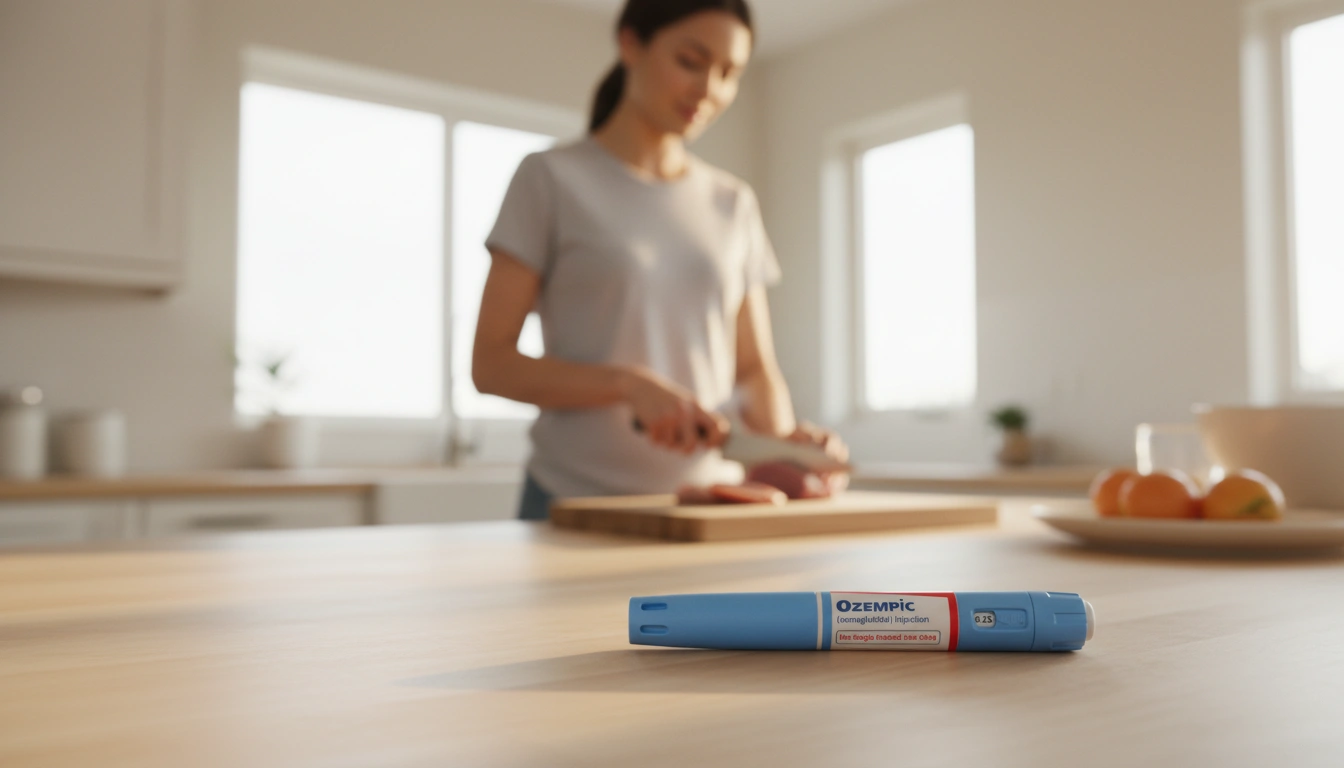What to Eat on Ozempic to Avoid Nausea

When embarking on a weight loss journey, the path can often feel daunting, particularly when navigating the intricacies of medication like Ozempic (semaglutide). This medication, primarily prescribed for type 2 diabetes, has gained traction as a weight loss aid due to its ability to suppress appetite and promote feelings of fullness. However, many individuals encounter a common hurdle: nausea. This blog post aims to provide you with a comprehensive understanding of what to eat on Ozempic to mitigate nausea while ensuring a balanced and nutritious diet.
Introduction
Did you know that nearly 20% of individuals taking Ozempic report experiencing nausea? This statistic underscores a critical aspect of managing your health while using this medication. As we delve into this topic, we will explore the types of foods that can help you navigate this side effect and enhance your overall experience with Ozempic.
Ozempic works by mimicking a hormone called GLP-1, which regulates appetite and slows gastric emptying, leading to prolonged feelings of fullness. While these mechanisms support weight loss, they can also contribute to gastrointestinal discomfort, including nausea. Recognizing which foods to embrace and which to avoid can significantly impact your journey.
In this article, we’ll cover the following key areas:
- The science behind Ozempic and its side effects
- Foods to eat that can help alleviate nausea
- Foods to avoid to minimize discomfort
- Practical tips for maintaining a balanced diet on Ozempic
- How to make the most of your experience with personalized weight loss solutions offered by TrimRx
By the end of this post, you’ll have a clearer understanding of how to optimize your diet while on Ozempic, making your weight loss journey smoother and more effective. Let’s get started!
Understanding Ozempic and Its Side Effects
Ozempic is a GLP-1 receptor agonist that helps manage blood sugar levels and supports weight loss. Its primary mechanisms include slowing stomach emptying and reducing hunger signals in the brain. While these benefits can be transformative, they may also result in side effects such as nausea, vomiting, diarrhea, and constipation.
The Mechanism of Nausea
Nausea is often linked to the delayed gastric emptying caused by Ozempic. As food remains in the stomach longer, it can lead to feelings of fullness and discomfort. High-fat foods, for example, are particularly problematic as they take longer to digest, exacerbating these symptoms. It’s essential to understand that the experience of nausea can vary widely from person to person, making it vital to personalize your dietary choices.
Managing Side Effects
At TrimRx, we recognize that managing side effects is crucial for your weight loss success. Our personalized weight loss programs include comprehensive consultations where we discuss your unique experiences and help you develop a tailored nutrition plan. If you’re considering Ozempic or are currently using it, we encourage you to take our free assessment quiz to see if you qualify for our prescription weight loss medications tailored to your needs.
Take the free assessment quiz here!
Foods to Eat on Ozempic to Reduce Nausea
When considering what to eat on Ozempic to avoid nausea, it's essential to focus on bland, low-fat, and easy-to-digest foods. Here’s a breakdown of recommended food categories:
1. Lean Proteins
Incorporating lean protein into your meals can help you feel fuller without contributing to nausea. Some excellent options include:
- Skinless chicken breast
- Fish (especially fatty fish like salmon)
- Turkey
- Tofu
- Eggs
These protein sources are not only nutritious but also help maintain muscle mass during weight loss.
2. Low-Fat Dairy Products
Low-fat dairy can provide essential nutrients while minimizing the risk of nausea. Consider including:
- Low-fat yogurt
- Greek yogurt
- Cottage cheese
These options are often lower in calories and fat while still delivering protein and calcium.
3. Non-Starchy Vegetables
Non-starchy vegetables tend to be lower in calories and high in fiber, making them ideal for a weight loss diet. Good options include:
- Spinach
- Broccoli
- Asparagus
- Bell peppers
- Zucchini
These vegetables are not only nutritious but also versatile for different meal preparations.
4. Whole Grains
Whole grains provide fiber and essential nutrients that support digestive health. Consider incorporating:
- Brown rice
- Quinoa
- Whole-wheat bread
- Oatmeal
These foods can help you feel satisfied and manage your hunger levels effectively.
5. Fresh Fruits
Fruits are packed with vitamins and can be a great addition to your diet. Opt for:
- Bananas
- Apples
- Blueberries
- Raspberries
These fruits are generally mild and less likely to irritate your stomach.
6. Nuts and Seeds
In moderation, nuts and seeds can be excellent sources of healthy fats and protein. Some good choices include:
- Almonds
- Walnuts
- Chia seeds
- Pumpkin seeds
Remember to keep portion sizes small, as they are calorie-dense.
Foods to Avoid on Ozempic to Minimize Nausea
While there are many foods that can help alleviate nausea, it’s equally important to understand what to avoid. Here's a list of foods that may exacerbate nausea and other gastrointestinal symptoms:
1. High-Fat Foods
Greasy and high-fat foods can slow digestion and worsen feelings of nausea. Examples include:
- Fried foods
- Cheesy dishes
- Fatty cuts of meat
These foods can linger in the stomach longer, leading to discomfort.
2. Spicy Foods
Spicy foods can irritate the stomach, especially for those who may already have a sensitive digestive system. If you notice discomfort after consuming spicy dishes, it’s best to limit them.
3. Sugar-Rich Foods and Drinks
Sweetened beverages and sugary snacks can lead to spikes in blood sugar and may also contribute to nausea. Avoid:
- Soda
- Candy
- Desserts
4. Carbonated Drinks
Fizzy drinks can cause bloating and gas, which may worsen nausea. If you're experiencing these symptoms, consider switching to still water or herbal teas.
5. Alcohol
Alcohol can exacerbate nausea and is also high in empty calories. Limiting or avoiding alcohol altogether is a wise choice while on Ozempic.
6. Foods High in Roughage
Certain fruits and vegetables that are high in fiber and roughage can lead to bloating and discomfort. Items like:
- Raw celery
- Pineapple
- Certain beans
may be best limited, especially in the early stages of adjusting to Ozempic.
Practical Tips for Maintaining a Balanced Diet on Ozempic
To make the most of your experience with Ozempic and minimize nausea, consider the following practical tips:
1. Eat Smaller, More Frequent Meals
Instead of three large meals, try consuming smaller portions throughout the day. This approach can help manage hunger and minimize nausea.
2. Stay Hydrated
Drinking plenty of water is essential, particularly as you may feel less inclined to eat. Staying hydrated can also aid digestion and overall well-being.
3. Keep a Food Journal
Tracking what you eat and how your body responds can provide valuable insights. Note any patterns that may emerge regarding foods that cause discomfort.
4. Cook at Home
Preparing your meals allows you to control the ingredients and portion sizes. Aim for simple, wholesome recipes that focus on lean proteins, vegetables, and whole grains.
5. Consult with a Registered Dietitian
Working with a registered dietitian can provide personalized guidance tailored to your unique needs. They can help you create a meal plan that aligns with your goals while considering your experiences with Ozempic.
Conclusion
Navigating your diet while on Ozempic can be challenging, particularly with nausea in the mix. However, by understanding what to eat and what to avoid, you can create a supportive and nourishing eating plan that promotes your weight loss journey.
At TrimRx, we are dedicated to providing personalized weight loss solutions that empower you every step of the way. As you embark on this journey, remember that you are not alone—our team is here to support you with tailored recommendations and ongoing support.
If you haven’t already, we encourage you to take our free assessment quiz to determine your eligibility for our personalized weight loss programs. Together, we can work towards achieving your goals in a safe and effective manner.
FAQ
Can I eat high-carb foods while on Ozempic?
While no food is strictly off-limits, high-carb meals may not be ideal due to their potential to spike blood sugar levels. It’s best to focus on balanced meals that include lean protein and non-starchy vegetables.
How long does nausea last when taking Ozempic?
Nausea is most common during the initial stages of treatment, particularly with dose increases. Most individuals find that nausea decreases over time as their body adjusts to the medication.
Is it safe to drink alcohol while on Ozempic?
While moderate alcohol consumption might be permissible, it’s best to limit intake due to its potential to exacerbate nausea and contribute to empty calorie consumption.
Should I consult a healthcare provider about my diet on Ozempic?
Absolutely! Consulting with a healthcare provider or registered dietitian can provide personalized guidance tailored to your needs and experiences.
What should I do if I experience persistent nausea on Ozempic?
If nausea persists or significantly impacts your daily life, it’s important to discuss this with your healthcare provider. They can offer advice and potential solutions to manage your symptoms effectively.

Transforming Lives, One Step at a Time
Keep reading
Skipping an Ozempic Dose: What You Need to Know
Discover what happens if you skip an Ozempic dose. Learn about immediate and long-term effects, plus expert advice on how to get back on track safely. Don’t risk your progress!
Ozempic Dosing: What is the Therapeutic Dose for Type 2 Diabetes Management?
Curious what is the therapeutic dose for Ozempic? Discover how personalized dosing optimizes blood sugar control & weight management. Learn more now!
Navigating Ozempic Dosing: What is the Smallest Dose of Ozempic and Why It Matters
Curious about what is the smallest dose of Ozempic? Learn why 0.25 mg is the starting point, how it works, and its role in a safe, effective weight loss journey. Discover personalized support today!



